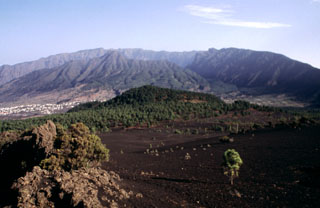Report on La Palma (Spain) — 1 December-7 December 2021
Smithsonian Institution / US Geological Survey
Weekly Volcanic Activity Report, 1 December-7 December 2021
Managing Editor: Sally Sennert.
Please cite this report as:
Global Volcanism Program, 2021. Report on La Palma (Spain) (Sennert, S, ed.). Weekly Volcanic Activity Report, 1 December-7 December 2021. Smithsonian Institution and US Geological Survey.
La Palma
Spain
28.57°N, 17.83°W; summit elev. 2426 m
All times are local (unless otherwise noted)
The eruption at La Palma continued during 1-7 December, characterized by Strombolian explosions and lava fountaining/jetting from multiple existing and new vents, advancing and sometimes branching lava flows, and almost daily ash emissions. Seismicity persisted at variable but elevated levels, with earthquake locations distributed at depths of 10-15 km and 30-40 km. Seismicity was intense at both levels during 30 November-2 December, though the intensity at deeper levels began to wane; in general, earthquake activity was low by the end of the week. Volcanic tremor levels fluctuated at medium to intense levels early in the week but by 3 December were also at low levels.
Several vents in the main cone continued to effuse lava, eject tephra, and emit ash-and-gas plumes. Lava moved W through pre-existing lava channels, lava tubes, over older flows, and over new ground, increasing the flow field that consists of overlapping flows (numbered 1-12) and two lava deltas. Persistent Strombolian activity was sometimes intense at the NE-flank vent during 1-3 December, and lava continued to feed flow 8 and the N delta. Lava fountains rose 400-500 m above the vent on 2 December. A new pyroclastic cone had formed around the vent, though it was unstable, and blocks from collapses of parts of it were transported downslope by lava flows. The northernmost flow, flow 12, traveled over new ground in the Fronton area and then rejoined flow 8 downslope. The flows reached part of the Tacande highway on 3 December. The vents in the main cone were quieter, periodically emitting ash and gasses. A N-S-oriented crack opened in an area 100 m S of the main vent, likely from subsidence, because it was not hot or emitting gas. The NE vent was quiet by 4 December.
On 3 December a new fissure opened on the SE of the main cone and produced Strombolian activity and fast-moving lava flows that traveled SW, along flow 10. The flow continued to advance W on 4 December, though at a slower rate as it moved over new ground in gaps between flows 3 and 11. Several new vents along an E-W fissure located W of Montaña del Cogote opened at noon on 4 December and produced multiple fast-moving lava flows. The flows descended SW over new ground, crossing into the municipalities of Tazacorte and Los Llanos de Aridane, destroying 60 homes. The flow joined flow 9, reached the sea cliff in the Las Hoyas area by 5 December, and descended the cliff the next day. During 6-7 December lava advanced W through multiple tubes and fed flows 1 and 2, and the S delta. The NE vent was quiet for a few days, but sporadic Strombolian activity and ash emissions had returned. Cracks and fractures in the upper part of the cone were visible. Several vents in the central and SE parts of the main cone also produced sporadic Strombolian activity and ash emissions. By 7 December lava had covered an estimated 11.82 square kilometers. The number of people that had evacuated and were staying in hotels had increased to 537.
Gas and ash emissions periodically impacted island residents. Suspended ash and high concentrations of volcanic gases triggered a few air-quality alerts mostly affecting the W part of the island; authorities warned residents in some areas to stay indoors. Residents and essential personnel were occasionally barred from entering the exclusion zones to irrigate crops and remove ash from streets and buildings. Ash-and-gas plumes visible during 1-3 and 6-7 December rose as high as 3.5 km a.s.l.; volcanic plumes drifted W, SW, and SSW all week, away from the airport. Daily measurements indicated that sulfur dioxide emissions persisted at “high” levels, indicating values of 1,000 to 29,999 tons per day.
Geological Summary. The 47-km-long wedge-shaped island of La Palma, the NW-most of the Canary Islands, is composed of two large volcanic centers. The older northern one is cut by the steep-walled Caldera Taburiente, one of several massive collapse scarps produced by edifice failure to the SW. On the south, the younger Cumbre Vieja volcano is one of the most active in the Canaries. The elongated volcano dates back to about 125,000 years ago and is oriented N-S. Eruptions during the past 7,000 years have formed abundant cinder cones and craters along the axis, producing fissure-fed lava flows that descend steeply to the sea. Eruptions recorded since the 15th century have produced mild explosive activity and lava flows that damaged populated areas. The southern tip of the island is mantled by a broad lava field emplaced during the 1677-1678 eruption. Lava flows also reached the sea in 1585, 1646, 1712, 1949, 1971, and 2021.
Sources: Instituto Volcanológico de Canarias (INVOLCAN), Instituto Geográfico Nacional (IGN), Gobierno de Canaries

